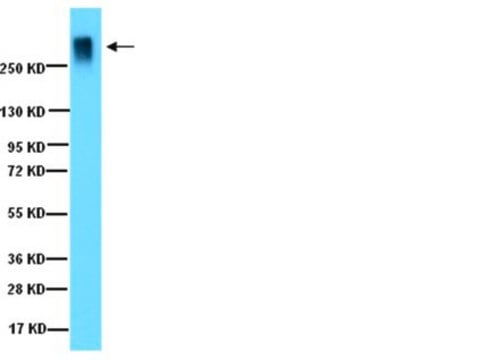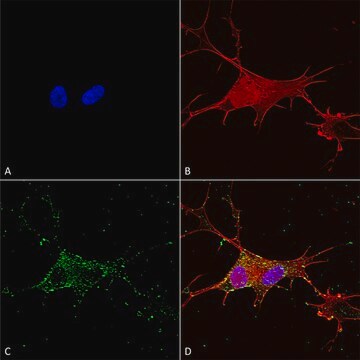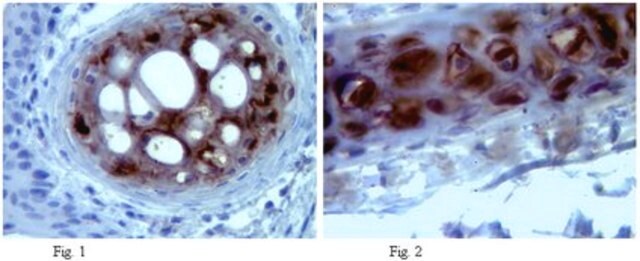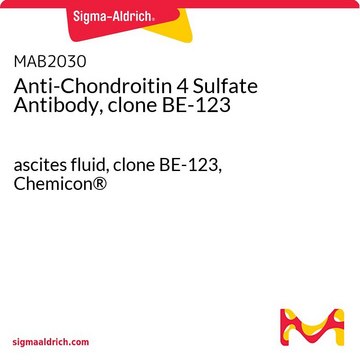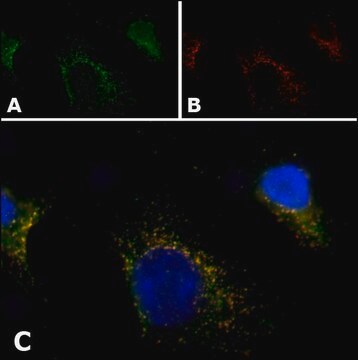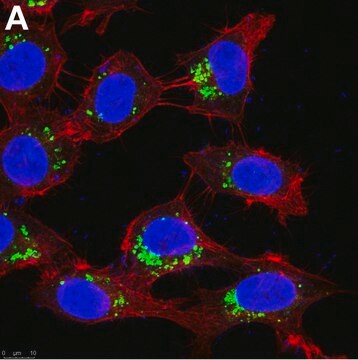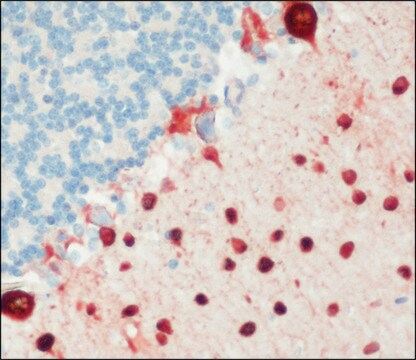MAB1581-I
Anti-Aggrecan Core Protein Antibody, clone Cat-315
About This Item
Polecane produkty
pochodzenie biologiczne
mouse
Poziom jakości
białko sprzężone
unconjugated
forma przeciwciała
purified antibody
rodzaj przeciwciała
primary antibodies
klon
Cat-315, monoclonal
masa cząsteczkowa
calculated mol wt 235.2 kDa
observed mol wt ~260 kDa
reaktywność gatunkowa
rat
reaktywność gatunkowa (przewidywana na podstawie homologii)
feline
opakowanie
antibody small pack of 100 μg
metody
western blot: suitable
izotyp
IgM
numer dostępu UniProt
Warunki transportu
dry ice
temp. przechowywania
-10 to -25°C
docelowa modyfikacja potranslacyjna
unmodified
informacje o genach
feline ... ACAN(101084542)
Opis ogólny
Specyficzność
Immunogen
Zastosowanie
Evaluated by Western Blotting in Rat brain tissue lysate.
Western Blotting Analysis: A 1:1,000 dilution of this antibody detected Aggrecan Core Protein in Rat brain tissue lysate.
Tested Applications
Western Blotting Analysis: A 1:1,000 dilution from a representative lot detected Aggrecan Core Protein in cortex tissue lysate.
Immunohistochemistry (Paraffin) Analysis: A 1:150 dilution from a representative lot detected Aggrecan Core Protein in rat brain tissue sections.
Immunocytochemistry Analysis: A 1:100 dilution from a representative lot detected Aggrecan Core Protein in Rat e18 cortical cells.
Immunoprecipitation Analysis: A representative lot immunoprecipitated Aggrecan Core Protein in Immunoprecipitation applications (Lander, C., et. al. (1998). J Neurosci. 18(1):174-83).
Immunohistochemistry Applications: A representative lot detected Aggrecan Core Protein in Immunohistochemistry applications (Grant, E., et. al. (2016). Cereb Cortex. 26(3):1336-1348; Lander, C., et. al. (1998). J Neurosci. 18(1):174-83; Quattromani, M.J., et. al. (2018). Mol Neurobiol. 55(3):2196-2213).
Immunofluorescence Analysis: A representative lot detected Aggrecan Core Protein in Immunofluorescence applications (Quattromani, M.J., et. al. (2018). Mol Neurobiol. 55(3):2196-2213).
Western Blotting Analysis: A representative lot detected Aggrecan Core Protein in Western Blotting applications (Choi, B.R., et. al. (2020). Cell Rep. 31(5):107540; Quattromani, M.J., et. al. (2018). Mol Neurobiol. 55(3):2196-2213; Lander, C., et. al. (1998). J Neurosci. 18(1):174-83).
Immunocytochemistry Analysis: A representative lot detected Aggrecan Core Protein in Immunocytochemistry applications (Lander, C., et. al. (1998). J Neurosci. 18(1):174-83).
Note: Actual optimal working dilutions must be determined by end user as specimens, and experimental conditions may vary with the end user
Postać fizyczna
Przechowywanie i stabilność
Inne uwagi
Oświadczenie o zrzeczeniu się odpowiedzialności
Nie możesz znaleźć właściwego produktu?
Wypróbuj nasz Narzędzie selektora produktów.
Kod klasy składowania
12 - Non Combustible Liquids
Klasa zagrożenia wodnego (WGK)
WGK 2
Temperatura zapłonu (°F)
Not applicable
Temperatura zapłonu (°C)
Not applicable
Certyfikaty analizy (CoA)
Poszukaj Certyfikaty analizy (CoA), wpisując numer partii/serii produktów. Numery serii i partii można znaleźć na etykiecie produktu po słowach „seria” lub „partia”.
Masz już ten produkt?
Dokumenty związane z niedawno zakupionymi produktami zostały zamieszczone w Bibliotece dokumentów.
Nasz zespół naukowców ma doświadczenie we wszystkich obszarach badań, w tym w naukach przyrodniczych, materiałoznawstwie, syntezie chemicznej, chromatografii, analityce i wielu innych dziedzinach.
Skontaktuj się z zespołem ds. pomocy technicznej
